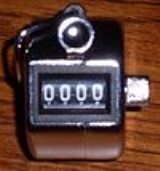
Tally counter
Encyclopedia
Description
A tally counter is usually made of metal and is circular in shape. Part of the circle is flattened out and contains a piece of clear plastic. Inside the counter are a number of rings with the numbers from 0 to 9 in descending order going clockwise. Most counters have four such rings, allowing the user to count up to 9999. A metal ring may be attached to aid in holding the counter, and usually half the ring is bent to fit flush with the counter.The counter is activated by pressing a button located above the screen. This will cause the first ring to advance one number. When the count has reached 0009, then the second ring will be advanced one click and the first ring will come back to zero. To reset the counter, a knob is located on the side. This knob turns all the rings which are displaying the same number (usually zero). When the number displayed reaches the number on the remaining rings, then they will turn too, until the display is reset back to 0000.
Electronic tally counters are available, which use an LCD screen to display the count, and a button to advance the count. Some also have a button to decrement the count, for example if a mistake is made, or if counting a majority.
Uses
The main application of tally counters is as people counterPeople counter
A people counter is a device used to measure the number and direction of people traversing a certain passage or entrance per unit time. The resolution of the measurement is entirely dependent on the sophistication of the technology employed. The device is often used at the entrance of a building so...
s. At concerts, stadiums, etc, a person will stand by the door with a tally counter recording the number of people that enter. At amusement parks, the rides can only hold a certain number of people, so the operator may use a tally counter to keep track of the number of people who get on the ride. They are also used for traffic analysis, scientific research, counting inventory and on industrial lines as well.
Tally counters have also been used in religion to count prayers, often replacing traditional prayer beads. Sikhs may use them to keep track of the number of times they chant the Mool Mantar. Gaudiya Vaishnava Hindus may use tally counters to keep track of the number of times that they chant the Hare Krishna Mahamantra. Initiated devotees are required to chant a certain number of 'rounds' each day, each round consisting of 108 mant.

